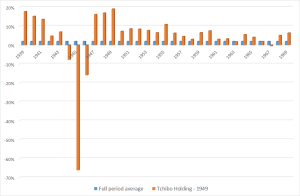
Fran Tarkenton once said, that “If you wait for the right time or the good times to start a business, you wait all your life.” I think, most of us would agree with him that there is no perfect time for any action or decision. Still, I believe, that the careful choice of the location and the inception date of a new venture can have a measurable impact on the probability of success. The aim of this article is to test this belief of mine by searching for some similar patterns of the macroeconomic environment around the year of establishment of the most successful family owned companies of Europe and US.
A vast amount of research has been done regarding the importance and the success factors of family enterprises. But only a small amount of the research activity is focusing on the role of the macroeconomic environment in the success or the failure of these companies. This article tries to identify some internationally significant macro factors of financial success. The first part of the text is summarizing the most important results of other researchers, the second part is introducing my own findings.
It’s a small world
Bloom, Genakos, Sadun and Van Reenen (2007) showed, that although there are clear differences in management performance across countries, there are even bigger differences between companies in the same country (for example the best third of Indian companies outperform the European average). These results encouraged me to ask the question, if the macroeconomic factors are having the same effect on family firms, regardless the country where these companies are operating in.
A bird in the hand is worth two in the bush
The article of Kachaner, Stalk and Bloch (2012) concluded, that family businesses keep the bar high for capital expenditures, and at the same time, these companies usually carry less debt than their peers. Based on these findings one would think, that family firms could outperform their peers in both a high interest rate environment (since these companies are having less of the currently expensive debt) as well as in a low interest rate environment (when asset returns are usually lower).
Macro matters
Watson, Hogarth-Scott and Wilson 1998 have researched the most important reasons of small business failures. Their results have shown, that in 65per cent of the failures the owners blame the poor cash-flow generating ability of the company, in 42 per cent the poor trading conditions and personal reasons, and in 40 per cent the poor long term prospects. This would imply, that a weak economy, or a recession could significantly increase the chance of a failure of a small business.
The focus of my research
My research question was motivated by the aforementioned articles. I was trying to identify some universal, international macro factors, which are having the same effect on the success of a family business, regardless the country the company is operating in. To do so, I was analyzing the economic environment around the inception date of the most successful family owned companies of Europe and US[1].
So many countries, so many customs
My research has showed, that there are some obvious differences between the different countries. In the US the inflation rate was clearly below average 7-1 years before the inception, and 1-6 years after it, whereas it was significantly [2]above average 12-16 years after the inception. In France inflation around the inception was higher than the average both before and after inception, and significantly higher 16-17 years after the start. In the UK, similar to France, inflation was higher than the average both before and after inception, with significantly higher figures 2-5 years before and 17 and 20 years after the first year. In Germany inflation was clearly lower than average both before and after the inception, and significantly lower 5-9 years before and 6-8, 10, 12 and 13 years after the inception. These results would suggest, that for the long term success of a German company a low, an English one a high inflation rate environment is more favorable.
All in the same boat
Although there are some interesting differences, my research has also showed, that there is an important pattern, which was observable in all of the countries covered by the analysis. This pattern was related to the real GDP per capita growth. This measure was – in some cases significantly – below average 2-5 years before inception, and was – in some cases significantly – above average in the year of inception, and 1-6 years after it. One could interpret this finding as it is favorable for the long term success of the company to start the business 2-5 years after a recession, during a boom phase of the economy.
A picture paints a thousand words
To illustrate the evolution of the real GDP per capita growth around the inception date, let’s consider the case of Tchibo. This company was founded in 1949. The following chart shows us the path of our indicator around the starting date.
The blue columns are showing us the average real GPD per capita growth rate for the period considered (between 1851 and 2014), 2.0 per cent. As the chart clearly reveals – and as we all know –, Germany was experiencing a serious depression 3-5 years before the inception of Tchibo, but the indicator was significantly higher than the average in the year of inception (4.5 per cent), as well as in the first few years of the life of the company.
Lessons learned
Based on the findings above we can conclude, that where and when does matter. It seems to be universally true, that a company is having a better chance of being successful on the long run, if it is founded 3-5 years after a recession, in the upswing phase of the economy. On the other hand, there are some important country specific factors, which could help us to give a more exact answer to the question, where and when to start a business to increase the probability of success.
Literature
Bloom, N., Genakos, C., Sadun, R., and Van Reenen, J. (2007). What drives good management around the world?. Centrepiece, 12(2), 12-17.
Kachaner, N., Stalk, G., and Bloch, A. (2012). What you can learn from family business. Harvard Business Review, 90(11), 102-106.
Watson, K., Hogarth-Scott, S., and Wilson, N. (1998). Small business start-ups: success factors and support implications. International Journal of Entrepreneurial Behavior & Research, 4(3), 217-238.
[1] My sample was including the top 100 family businesses based on the revenue of the company.
[2] I was using a 90 per cent confidence level in my research, but most of my results are still valid at a 95 per cent confidence level, and some of them at a 99 per cent level.




